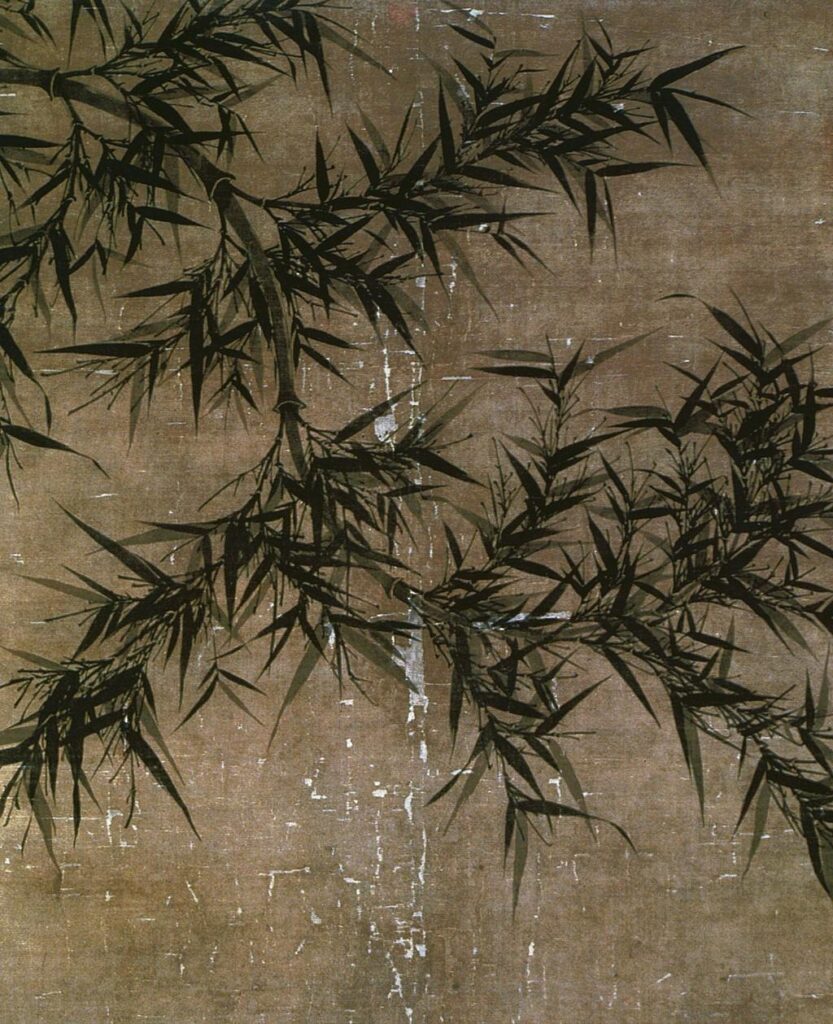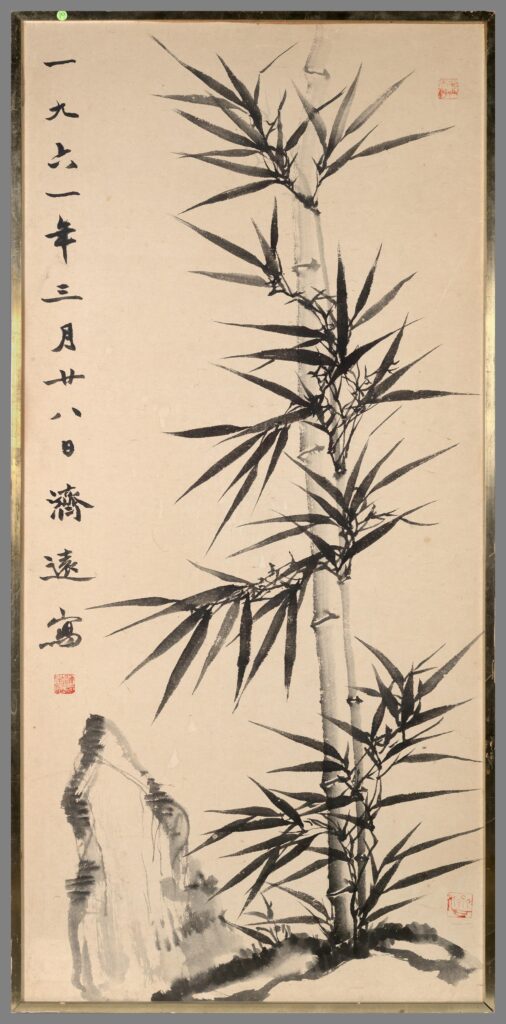Kathryn Suplee
Overview
This exhibition focuses on Chinese ink art with a subject of bamboo. The exhibition emphasizes the importance of bamboo in Chinese culture and its transmission across centuries.
Transmission is one of the six principles of Chinese art developed by Xie He, meaning the copying of models not only from life but also the works of antiquity. Xie He was a Chinese figure painter and critic who lived during the 6th century. The other principles he created are spirit resonance/vitality, bone method (the way of using the brush), correspondence to the object (the depicting of form), suitability to type (the application of color), division and planning (placing and arrangement), and transmission by copying. These principles captured my attention when first introduced and can be seen in most Chinese Art or be a way to critique the art itself. They helped to develop art throughout the centuries, which allows for the idea of transmission to be especially powerful.
The idea of ‘copying’ is seen as an appreciation of ancient masters and an understanding of the art itself throughout different time periods. Transmission can be seen in the five selected images below as they range from 1070 to 2012 in their dates, but a similar theme and art style can be traced through all five of them. These works are similar in terms of line work and the use of traditional black ink to depict the bamboo. The flow of the brushstrokes shows the vitality of the bamboo and makes it appear to be shifting and moving in the wind.
The works emphasize the importance of bamboo in Chinese culture, as China is known as a country to have much bamboo and it is used for food, clothing, housing, transportation, musical instruments, weapons, paper, and more. It’s use as paper has been particularly important as it has allowed for Chinese culture and history to be recorded for the modern day. Bamboo itself is said to represent honor, chastity, modesty, and resoluteness based on different parts of the plant itself, such as the hollow interior, deep roots, etc. Additionally, it represents virtue and the people of China themselves in terms of emotions and harmony. The works demonstrate this as each uses a single bamboo stem as the focus, and are accurate in terms of anatomy of the plant as well as conveying that it has vitality and spirit.
Using all mediums of ink on paper and a focus of bamboo demonstrates transmission perfectly, and would allow for an exhibition to look deeper into how they are similar. The exhibition room these pieces would be structured in would place the pieces hanging vertically on the wall, surrounded by glass. The focus of bamboo would be accentuated with different items made of bamboo encased in glass in the room as well as bamboo in pots to feel its importance in Chinese culture.

Title: Bamboo
Artist: Wen, Tong
Date: 1070
Size: 132.6 x 105.4 cm
Medium: Ink and color on Silk
Culture: Chinese, Sung Dynasty
Repository: University of California San Diego
Description: This work features a bamboo stem coming from the top left corner branching downward. The stem seems both rigid and fluid at the angle it is bent at, with leaves coming from the stem appearing sharp and dark in terms of brush work. They appear to have been made with lots of pressure, and tapering off at the end. There is contrast between the plant and the background, which seems to have browned with age. There are splotches of white coming through the brown as though worn away or scraped off.

Title: Bamboo
Artist: Wu Changshuo
Date: Late 19th-Early 20th Century (Qing Dynasty)
Size: Without Mounting: 179.7 x 47 cm, with Mounting: 238.8 x 60.3 cm
Medium: Hanging Scroll, Ink on Paper
Culture: Chinese
Repository: Yale University Art Gallery, Asian Art
Id Number: 79298
Description: The piece features a rock on the ground next to where the bamboo is sprouting from. It highlights the hard nature of the rock and is mirrored with the rigid, unbent posture of the bamboo stem. The leaves coming from this stem are less frequent than other pieces, and appear thinner and more delicate than others. There is calligraphy on the left side of the work, most likely a poem as well as the red author’s stamp. This work demonstrates the culture of bamboo as a strict plant that is a key part of the landscape, especially in China.

Title: Bamboo
Artist: Li Mu-ch’iao
Date: 1931
Size: 80 ½ x 18 in, image 53 x13 in
Medium: Scroll, Ink on Paper
Culture: Chinese
Repository: The Chu-Griffis Asian Art Collection, Shain Library Connecticut College, New London, Connecticut
Description: This work features a bamboo stem erecting from the middle of the bottom part of the paper. There is a contrast of color in the Chinese black ink, as the leaves are darker than the stem. There is a long line of calligraphy on the left side of the scroll, possibly a poem, as well as a red signature of the artist in the bottom left corner of the work. This work is similar to the last work as the viewer’s eyes are drawn along the bamboo stem to the leaves as it appears in movement and flowing in the wind. It is not a rigid plant, and the leaves are made with fast and heavy brush movements. Some leaves have different colors due to less ink or pressure being used to make them appear overlapping as the darker leaves are on top.

Title: Bamboo
Author: Wang Chi-Yuan
Date: 1961
Size: Fram 48 7 1/16 x 23 ¼ in
Medium: Ink on Paper
Culture: Chinese
Repository: Williams College Museum of Art, Gift of the School of Chinese Brushwork
Accession Number: 89.20.2
Description: In this work the bamboo stem appears very delicate in its thin brushstrokes as well as the contrast to the rock to its left. The rock appears a pale blue while the bamboo and leaves are done in traditional black Chinese ink. The leaves appear erratic, and add to the thin stem, demonstrating Chinese characteristics of bamboo as both firm and soft, gentle and tough. This work is similar to others as the bamboo appears to be flowing and the leaves are darker than the stem.

Title: In the Wind
Artist: Mansheng Wang
Date: 2012
Size: 4ft x 2 ft 6 in
Medium: Ink and Walnut on Paper
Purchased from the artist, 2021
Repository: The Chu-Griffis Art Collection, Connecticut College, New London, Connecticut
Description: The work uses traditional Chinese ink that is dark black, with a lighter gray behind the stark black. This is shown in the close up image below, and could demonstrate movement, with the lighter gray being the bamboo’s old spot, and the black bamboo showing its current position after moving, possibly from wind. It gives the work a sense of movement and vitality, as well as sets it apart from the strict landscape pieces that Wang also has. The soft, flowing brushstrokes are curved with the leaves and strict/straighter in the stem to portray realism with the bamboo as well as fluid movement. This work was available to me in the Chu-Griffis Collection and I wawa able to take pictures and inspect the fine details of the work. Mansheng Wang is the most modern artist in this collection, and transmission is clear in his depiction of bamboo with his brushstrokes, bamboo subject, and the manner in which the bamboo is both rigid and flowing in the wind. Mansheng Wang currently lives in the US and has planted his own bamboo in his backyard backing up to the Hudson Valley River. He mixes both Chinese and US influences and his planting of bamboo in the US represents how he brought Chinese culture to the US.
Bibliography:
Images Links:
Used Artstor and Luna
Wen, Tong, 1018-1079. c.1070. Bamboo. hanging scroll. https://library.artstor.org/asset/ARTSTOR_103_41822000410793.
Wang Chi-Yuan, 1895-1975. 1961. Bamboo. painting. Place: Williams College Museum of Art, Gift of the School of Chinese Brushwork. https://library.artstor.org/asset/AWSS35953_35953_42328291.
Wu Changshuo, (1844 – 1927). late 19th – early 20th century. Bamboos. Paintings. Place: Yale University Art Gallery, Asian Art, http://artgallery.yale.edu/. https://library.artstor.org/asset/AYALEARTIG_10312578248.
Li Mu-ch’iao, Chinese, 1931-. Bamboo. scroll. Place: Chu-Griffis Asian Art Collection, Shain Library, Connecticut College, New London, Donated by Eugene Ching. https://library.artstor.org/asset/CONNASIAN_106310617227.
“In the Wind.” – Chu-Griffis Collection of Asian Art, https://conncoll.lunaimaging.com/luna/servlet/detail/ConnColl~2~2~494~1184?qvq=w4s%3A%2Fwhere%2FChinese%2F%3Blc%3AConnColl~2~2&mi=2&trs=8.
Texts:
Chia, Lucille. “Printing and Publishing in East Asia through Circa 1600: An Extremely Brief Survey.” Mediaevalia (Binghamton, N.Y.) 41, no. 1 (2020): 129–162.
Gioia, Dana. “Disappearing Ink: Poetry at the End of Print Culture.” The Hudson review 56, no. 1 (2003): 21–49.
Peng, Hui, Jiali Jiang, Jianxiong Lu, and Jinzhen Cao. “Application of Time–Temperature Superposition Principle to Chinese Fir Orthotropic Creep.” Journal of wood science 63, no. 5 (2017): 455–463.
Porterfield, Willard Merritt. Bamboo, and Its Uses in China Peking: Chinese Government Bureau of Economic Information, 1926.
Rowley, George. Principles of Chinese Painting : with Illustrations from the Du Bois Schanck Morris Collection Princeton, N.J: Princeton University Press, 1947.
Silbergeld, Jerome. “Chinese Concepts of Old Age and Their Role in Chinese Painting, Painting Theory, and Criticism.” Art journal (New York. 1960) 46, no. 2 (1987): 103–114.
Wang, Shixiang, and Wan Go H. C. Weng. Bamboo Carving of China New York, N.Y. (125 E. 65th St., New York 10021): China House Gallery, China Institute in America, 1983.
Wong, Wucius. The Tao of Chinese Landscape Painting : Principles & Methods 1st ed. New York: Design Press, 1991.
Yoonjung, Seo. “A New Way of Seeing: Commercial Paintings and Prints from China and European Painting Techniques in Late Chosŏn Court Painting.” Acta Koreana 22, no. 1 (2019): 61–87.